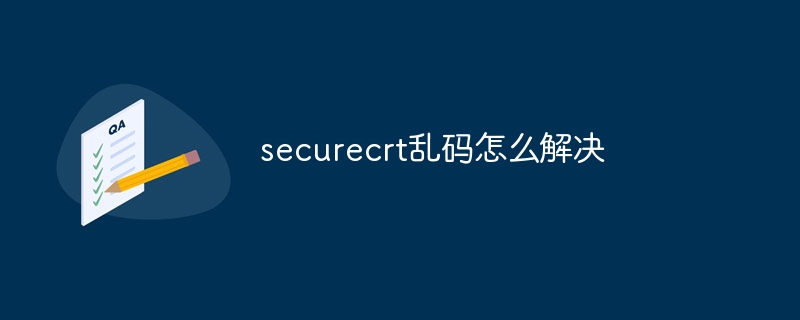securecrt garbled characters can be solved by checking character encoding settings, changing font settings, checking locale settings and contacting securecrt support. Detailed introduction: 1. Check the character encoding settings, open securecrt, click "Options" in the menu bar, select "Session Options", select the "Terminal" tab, select the appropriate character encoding in the "Character encoding" drop-down menu, and click "OK" "Save the settings and close the window, etc.

securecrt garbled problem may be caused by the following reasons:
1. Character encoding Mismatch:
securecrt garbled problem may be caused by character encoding mismatch. When using securecrt to connect to the server, you need to ensure that securecrt and the server use the same character encoding. Common character encodings include UTF- 8. GBK, etc. You can try to change the character encoding settings in securecrt to be consistent with the server’s encoding.
2. Font setting problem:
securecrt garbled code problem is still there It may be related to font settings. Different fonts have an impact on the way characters are displayed, which may cause garbled characters. You can try changing the font and choose a font that supports the required character encoding. Generally speaking, fixed-width fonts (such as Courier New, Consolas, etc.) are more suitable for displaying terminal output in securecrt.
3. Locale setting:
securecrt garbled problem may also be related to the locale setting of the operating system. Ensure that the operating system and securecrt use the same language environment to reduce the occurrence of garbled characters. You can select the appropriate language in the operating system's language settings and then restart securecrt.
The method to solve the securecrt garbled problem includes the following steps:
1. Check the character encoding settings:
In securecrt, you can do the following Steps to check and change character encoding settings:
Open securecrt, click "Options" in the menu bar, and select "Session Options".
In the pop-up window, select the "Terminal" tab.
Select the appropriate character encoding in the "Character encoding" drop-down menu, such as UTF-8 or the encoding used by the server.
Click "OK" to save the settings and close the window.
2. Change the font settings:
In securecrt, you can change the font settings through the following steps:
Open securecrt and click " Options", select "Session Options".
In the pop-up window, select the "Appearance" tab.
Select the appropriate font in the "Font" drop-down menu, such as Courier New or Consolas.
Click "OK" to save the settings and close the window.
3. Check the locale settings:
In the operating system, you can check and change the locale settings through the following steps:
Open the operating system control panel or settings.
Find the "Language" or "Region and Language" option and click to enter the settings page.
Make sure the same locale as securecrt is selected, such as English or another language.
Restart securecrt and check whether the garbled code problem is solved.
4. Contact securecrt support:
If the above method cannot solve the garbled problem, you can contact securecrt’s technical support team for help. They can provide more professional guidance and solutions.
To sum up, securecrt garbled problem may be caused by character encoding mismatch, font setting problem or locale setting problem. You can solve the problem of garbled characters by changing character encoding settings, changing font settings, and checking locale settings. If necessary, you can contact securecrt's technical support team for help.
The above is the detailed content of How to solve securecrt garbled code. For more information, please follow other related articles on the PHP Chinese website!